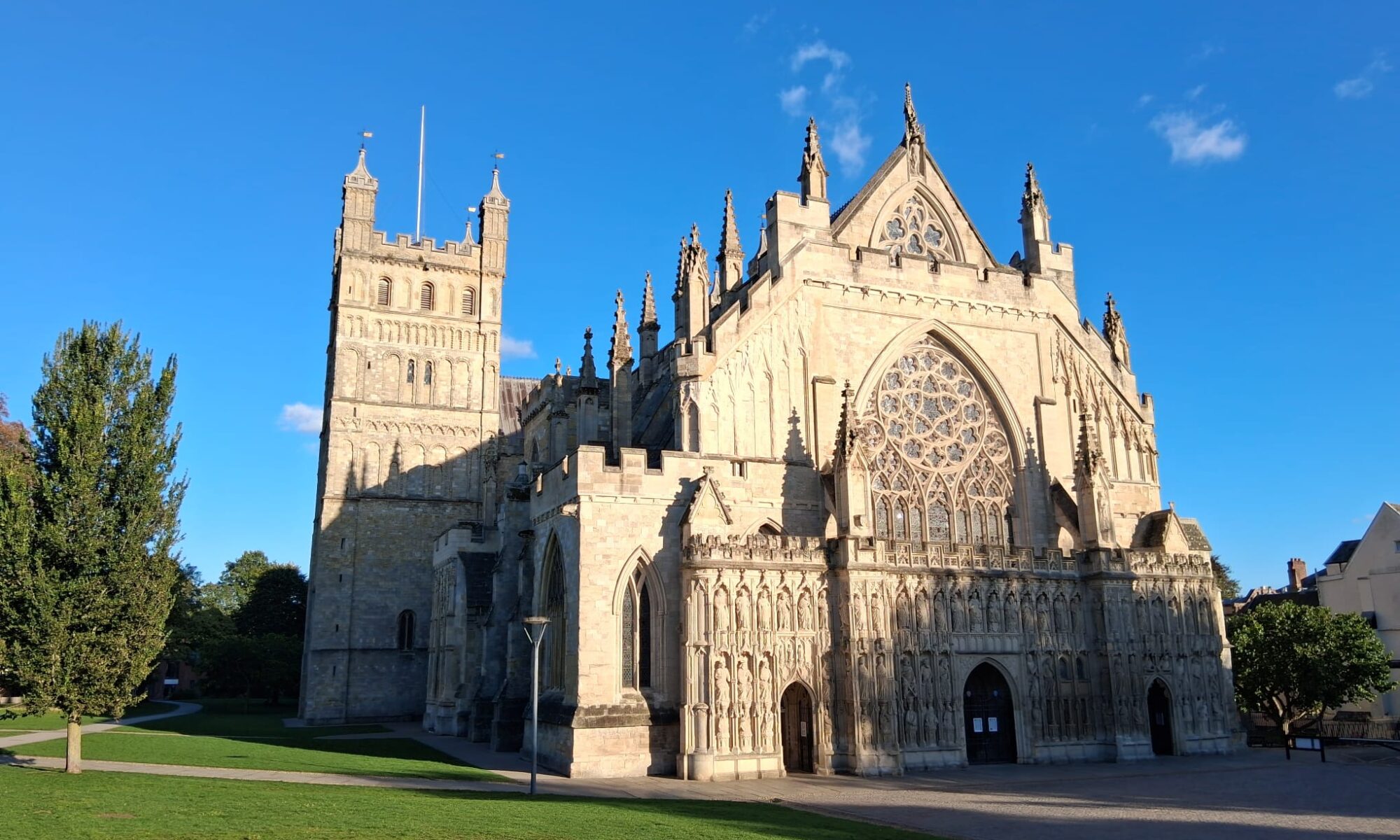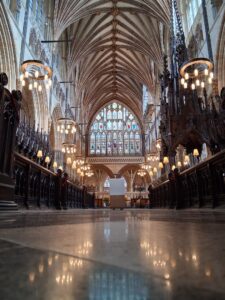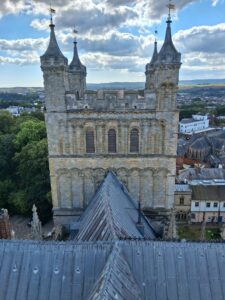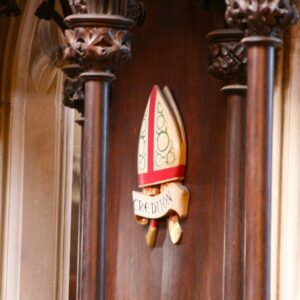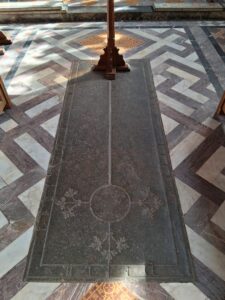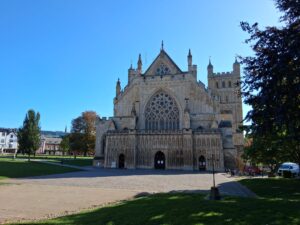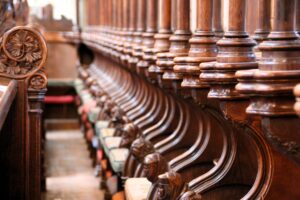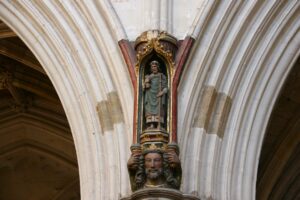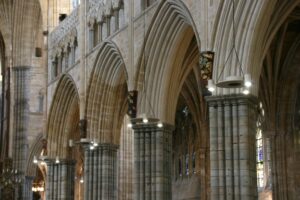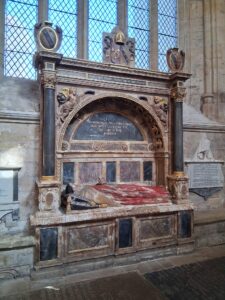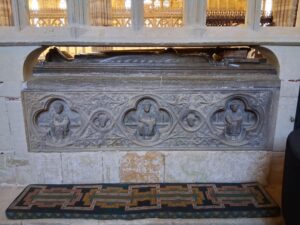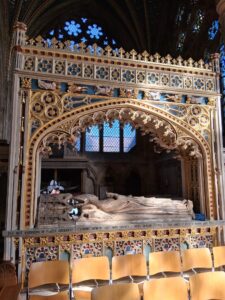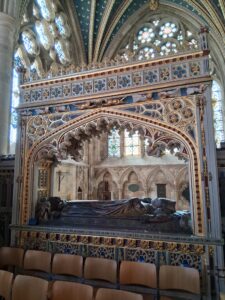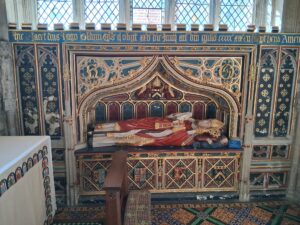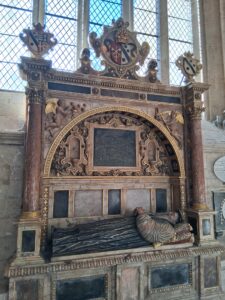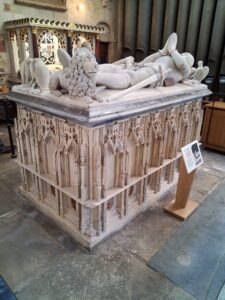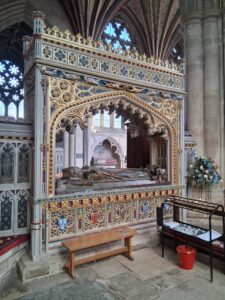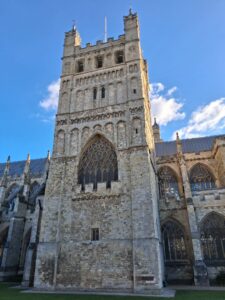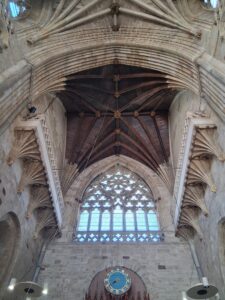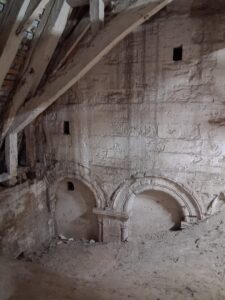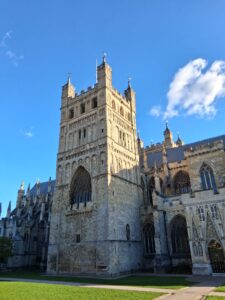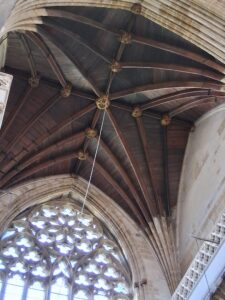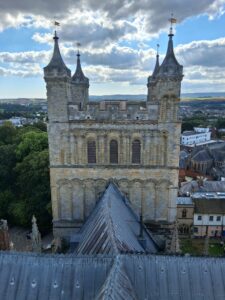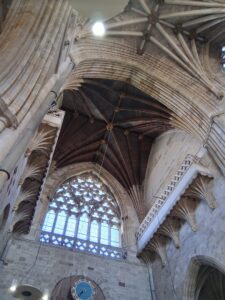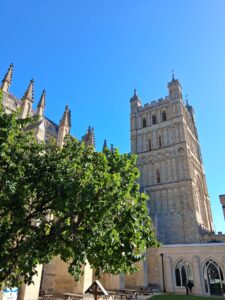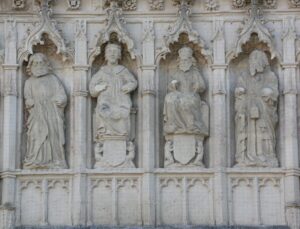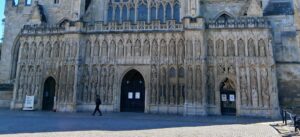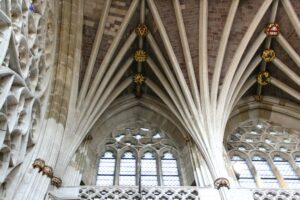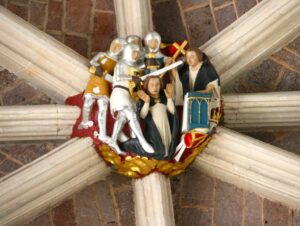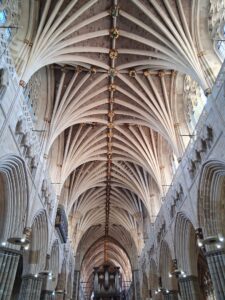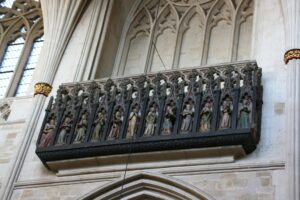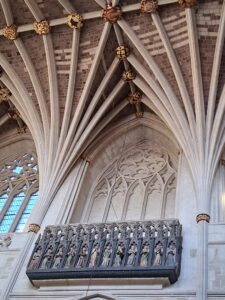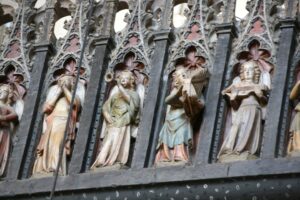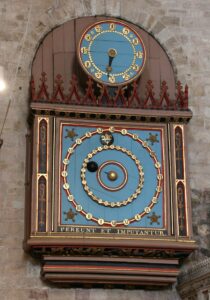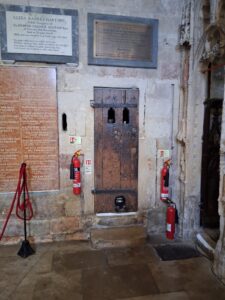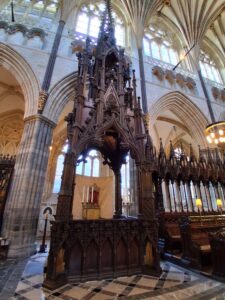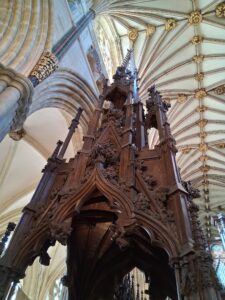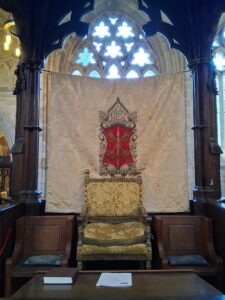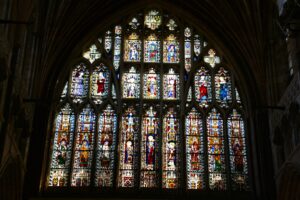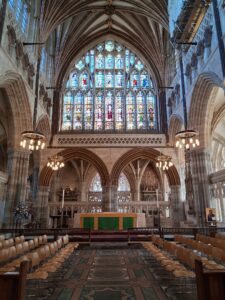Exeter Cathedral is one of the great cathedrals of England. The anglican cathedral is properly known as the Cathedral Church of Saint Peter. For nearly 1000 years it has stood proud and dominated the cathedral green in the heart of the city. The city of Exeter is the administrative centre and capital of the English county of Devon in the southwest of England. Exeter cathedral is the mother church of the Diocese of Exeter and throne of the Bishop of Exeter.
Exeter Cathedral is a place of worship, full of history, unique in design and home to some fascinating features. In this guide I will explore these features which include the medieval west front image screen, an intriguing minstrel’s gallery, an astronomical clock, a towering bishop’s throne, a couple of impressive Norman towers, stunning vaulted ceiling and the impressive great eastern window.
Visiting Exeter Cathedral
Exeter Cathedral Location
Opening times of Exeter Cathedral
Exeter Cathedral is generally open 9-5 Monday through to Saturday. On Sunday reduced hours are 11.30-3. Depending on how you wish to visit will determine the time you spend in the cathedral.
Admission prices of Exeter Cathedal
If you are visiting to pray and worship, then entry to the cathedral is free. If you’re looking to explore the cathedral then an admission fee is charged (currently £10 – if you gift aid, you can return visit as many times as you want or are able in a 12-month period). The wealth that cathedrals enjoyed in their hey days is long gone, so the admission fee helps towards maintenance of such an incredible building.
Tours of Exeter Cathedral
These are invaluable sources of knowledge and information and have helped me bring these guides and information to you. Exeter offers a 60-minute tour as part of the admission ticket. They do offer other tours, most notably the Onwards and Upwards tour. It cost £22.50 and was worth every penny. Access is provided to the top of North Tower (weather permitting) for wonderful views over the city of Exeter. On the tour you will walk above the vaulted ceiling and underneath the disjointed roof. There are other tours available. Please let me know if you’ve been on any.
Exeter Cathedral History
Founding of Exeter Cathedral
The first bishop of Exeter was Leofric in 1050 (buried in the Lady Chapel). Leofric moved from his then current base in Crediton after gaining permission from the Pope and King Edward ‘the Confessor’ (former King of England and buried in Westminster Abbey). Prior to this change Devon’s bishop was based in Crediton which is to the northwest of the city in mid Devon.
There have been several buildings on the cathedral site. The first cathedral was dedicated to St Peter. It is marked by a standing metal cross near the steps in front of the Western entrance of the current cathedral. Bishop Leofric established a cathedral community that was secular, ‘a brotherhood of canons’ working for the bishop. Exeter Cathedral was never monastic, which is an important fact to remember when considering what took place during the reformation.
Norman Cathedral
In 1114 works were begun to build a new cathedral by Exeter’s third bishop, Walter Warewast. This was Exeter’s 2nd cathedral and built in the Romanesque style. Norman cathedrals were built like castles – strong thick walls with very few windows. The only remaining evidence of this part of the building is the North & South towers. Completion was completed towards the end of the 12th century. The partly completed Norman castle was consecrated in 1133. The Norman (Romanesque) cathedral was completed in 1180.
3rd Cathedral
Work began on a new gothic cathedral in 1270. It would take another 100 years or so to complete the building that we admire today. Inspiration for the new cathedral was taken from the cathedral at Salisbury. Work began at the eastern end with the Lady Chapel and flanking chapels.
In 1286 Edward I visited the city to preside over the trial of Lechlade’s murder that had taken place in 1283. The murder, or at least the escape of the perpetrators, was made easy by the fact that the south gate in the city’s fortifications had been left open. Before Edward left he granted permission for Bishop Quinil to construct a 12’ high security wall around the cathedral precinct. This wall included 7 gates. This was like other cathedrals in the land, for example, at Norwich and Winchester. Lincoln begun building a similar wall in 1285 with Edward I’s permission. Other examples can be seen in Wells, Worcester, Canterbury & Chester.
Bishop Walter Stapledon (1308-26 – Walter founded Exeter College in Oxford with his brother) had a major piece of cathedral furniture constructed and this remains to this day. This is the bishop’s throne canopy, sometimes referred to as the cathedra. This medieval piece of woodwork stands 16m tall and is made from local Devon oak.
Building the Nave
By 1328 the cathedral works had progressed to the eastern end of the nave. Work was done to include the two Norman towers as the transepts. This unique design is different from other England cathedrals that favour the central tower. This design allowed the longest vaulted stone ceiling in the world to be created.
The nave was built on top of the old Romanesque church footprint with the work being completed in 1342. Evidence can be seen when looking around the walls of the nave of the old existing church.
Work began when the nave was completed to build the screen that is visible on the outside at the western end of the cathedral. This was done in several stages and by different bishops. The completion of the screen shows how much of an afterthought it was as it was built over the bottom end of the Western window!!
Victorian Restoration of Exeter Cathedral
A name that was mentioned continuously throughout the tour was that of Sir George Gilbert Scott. During the Victorian years he led a program of renovations which uncovered and restored original elements of the building.
Exeter Cathedral Tombs
Sadly, there are no royals buried at Exeter Cathedral. Most of the tombs are of bishops. Bishops back in the day were more than bishops – they were landowners, politicians etc. There is one tomb of particular interest that will pave, I hope, the way to further explorations.
In the southern transepts there is a monument to Hugh Courtenay, 2nd Earl of Devon, and his wife Countess Margaret. Sir Hugh was owner of Tiverton and Okehampton Castles and played an important role in the Hundred Years wars. His son would go on to become the Archbishop of Canterbury. The Courtenay family still exists today and resides in Powderham Castle just outside of Exeter.
Dotted around the quire and in chapels are several tombs and these include Bishop Leofric, Bishop Henry Marshal (related to the famous William Marshal discovered in recent meanderings to Wales), Bishop Walter Stapledon, Bishop Edmund Stafford, Bishop Walter Bronescombe and Bishop Hugh Oldham.
Fascinating features
Norman Towers
The two Romanesque towers are the oldest parts of the building, dating back to the early 12th century. Admire them equally from the outside and the inside. On the outside you will notice the Romanesque style, its lack of windows, almost castle like. From the inside – stand in the towers and look up and you will see a timber vaulted ceiling. The southern tower houses the bells.
West Front Image Screen
The screen was completed in two phases between 1342 and 1480. In the screen you will find figures of angels (the bottom row), kings, prophets and saints (the upper rows). On close inspection you will notice that some are missing or damaged. The screen was an afterthought, as clearly shown when you look at the top of the screen it obstructs the bottom of the western window. In its heyday this stonework would have been highly coloured and is described as a vision of heaven.
Vaulting
The longest continuous medieval stone vault in the world. Sprinkle in over 400 incredibly detailed ‘bosses’ and it leaves you standing in amazement at the vibrant display. Concrete versions of palm trees were laid to support the ceiling. These are symmetrically aligned all the way through the nave. It is a true display and testament of the incredible craftsmanship of builders back in the day. Truly astonishing. The style of vaulting is known as ‘tierceron’.
Minstrels’ Gallery
When walking along the centre aisle of the nave, look above the gothic arches on the northern side. You will notice something unique. It is called the Minstrels’ gallery. Built in 1350, its purpose is unknown, but the gallery is adorned with 14 carved angels. If you look closely 12 of them are playing medieval instruments.
Astronomical Clock
On the wall in the Northern tower, you will find the Astronomical clock dating back to 1484. The centre of the clock is the earth represented by a golden ball. The black ball in the next ring is do with the moon with the outer ring pointing to the hour of the day. Beneath the clock is a door with a fascinating entrance. This was for the cathedral cat (the original cat flap?) who would kill the rodents who feasted on the mechanism for the clock.
Bishop’s Throne
In the choir (quire) area of the cathedral you will find the bishop’s throne. It is like nothing I’ve seen before. It dates to early 14th century. The Devon oak used in its construction is held together with wooden pegs. It is huge (Why? one asks), at over 50 feet tall. Thankfully the throne was taken out of the cathedral during World War Two (WW II) to save it from any damage.
Great East Window
The glass in this incredible window dates from around the 14th century. Thankfully, like the bishop’s throne, it was taken out and stored safely during WWII. This foresight (Exeter was badly bombed during the war) means we can appreciate the incredible display. It is best seen with the sun behind to show off the colour of the glass. The top three figures in between the tracery at the top of the window are Abraham, Moses and Isaish.
Exeter Cathedral Summary
It is said that Exeter Cathedral is one of the ‘great cathedrals of England’. My mission now is to visit all the cathedrals in England and see if this statement is true. It certainly is an impressive place to visit. The longest vaulted ceiling is something to behold.
People have preferences when visiting cathedrals. Some prefer exploring on their own especially if pushed for time. Others favour knowledge being shared with them. This was the first time I had completed a tour of a cathedral. It was highly informative and very insightful. What also made it was the tour guide. He mentioned that a visit to the church at Ottery St Mary, might be beneficial as the church there resembles this masterpiece. Challenge accepted.
My visit has inspired me to explore a couple of places local to Exeter. Crediton to see if there is any evidence of the earlier Bishopric before it moved to Exeter. The second place picked up on this visit is that of Powderham Castle where the Courtenay family lives.

